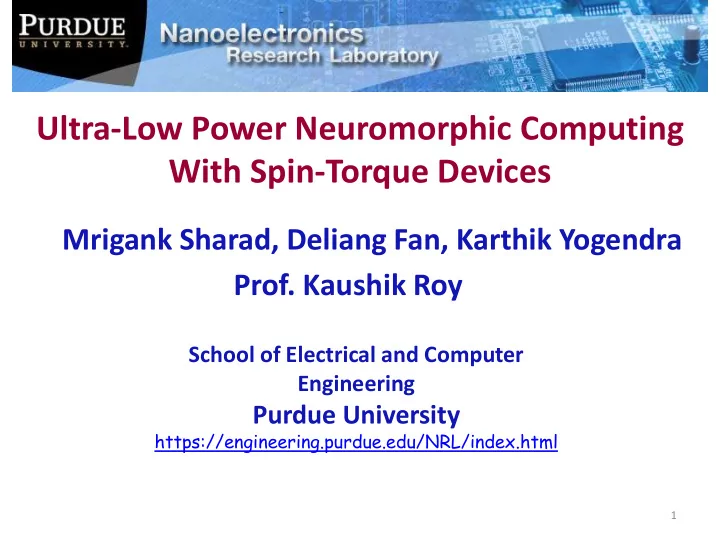

Ultra-Low Power Neuromorphic Computing With Spin-Torque Devices Mrigank Sharad, Deliang Fan, Karthik Yogendra Prof. Kaushik Roy School of Electrical and Computer Engineering Purdue University https://engineering.purdue.edu/NRL/index.html 1
Boolean Computation using Spin Torque Device • Three orders of magnitude higher density as compared to 15 nm CMOS design • By proper pipelining, 3D stacking and clocking transistor sizing, we can get comparable power consumption and performance to state of art CMOS technology
Non-Boolean Computing • Traditional computing models (Boolean logic, von Neumann architectures) are highly inefficient at performing tasks that humans routinely perform, such as visual recognition, semantic analysis, and reasoning. • Bio-inspired computation can outperform Von-Neumann designs in many such data Processing applications
Non-Boolean Computing with STT Devices CMOS circuits for artificial neurons can be too complex and power hungry for designing large scale non-Boolean/neuromorphic hardware • Designed ultra-low voltage and high-speed current-mode switches using spin-torque devices that can mimic ‘neuron’ • Developed device-models for spin-neurons and explored their application in the design of ultra-low power neuromorphic circuits and architectures
Bipolar Spin Neuron Device Structure Device operation • The neuron device essentially acts as an ultra low voltage current comparator and can be employed to perform analog-mode computation 5
Communication Through Synapses (a) (b) • Memristors/DWM/DTCS can be used for realizing low power neuromorphic computation array using bipolar spin neuron • The magneto-metallic neurons facilitate input voltage levels of ~20mV resulting in low computation power 6
Example Synapse: Domain Wall Magnet • A DWM consists of opposite polarity domains separated by a Non- magnetic region call the domain wall which can be moved by charge injection/ magnetic field 7
“Spin Neuron” with Domain Wall Magnets as Synapses Domain wall synapse with channel interface • Neuron with small number of programmable DWM inputs can be employed to realize configurable data processing array of cellular neurons 8
Drawing Analogy with Biological Neural Network 9
Spin Based Neuron for Cross-Bar Neural Network • The spin based neuron unit achieves ~100X improvement in power consumption for cross bar ANN architecture Based on memristor/PCM 10
Ultra Low Energy Analog Signal Acquisition and Processing ADC + APU + u ij DSP B A • Hardware based on Cellular neural networks can be employed in several image processing applications • Each pixel in a CMOS sensor array may contain analog processing units along with DSP • Analog units lead to large power consumption even for simple image processing applications • We employ spin-CMOS hybrid PE to achieve ultra low energy analog computation 11
Results for Image Processing using CNN Results show the possibility of more than ~100x energy-improvement over state-of the art CMOS for neuromorphic computing: Half-tone extraction Halftone sensing and compression 12 • Low voltage, compact and fast switching spin-neurons can provide the essential neuron functionality, leading to ultra-low energy and high-density neuromorphic/non-Boolean computing systems .
Summary • We explored the possibility of non-Boolean computing using Spin Torque Devices • We noted that current-mode switching of STT-devices can be employed in ultra low power analog computing • Spin- ’neurons’ can lead to ultra low power non -Boolean architectures based on resistive memory , due to ultra low voltage, low current operation. Such design can be applied to numerous applications like associative computing , programmable threshold logic and neuromorphic hardware design. • We plan to explore the application of STT devices in global interconnect design • Design challenges related to precise voltage supply generation and distribution will be explored. Funded by: DARPA, MARCO, StarNet, SRC and NSF 13
Recommend
More recommend